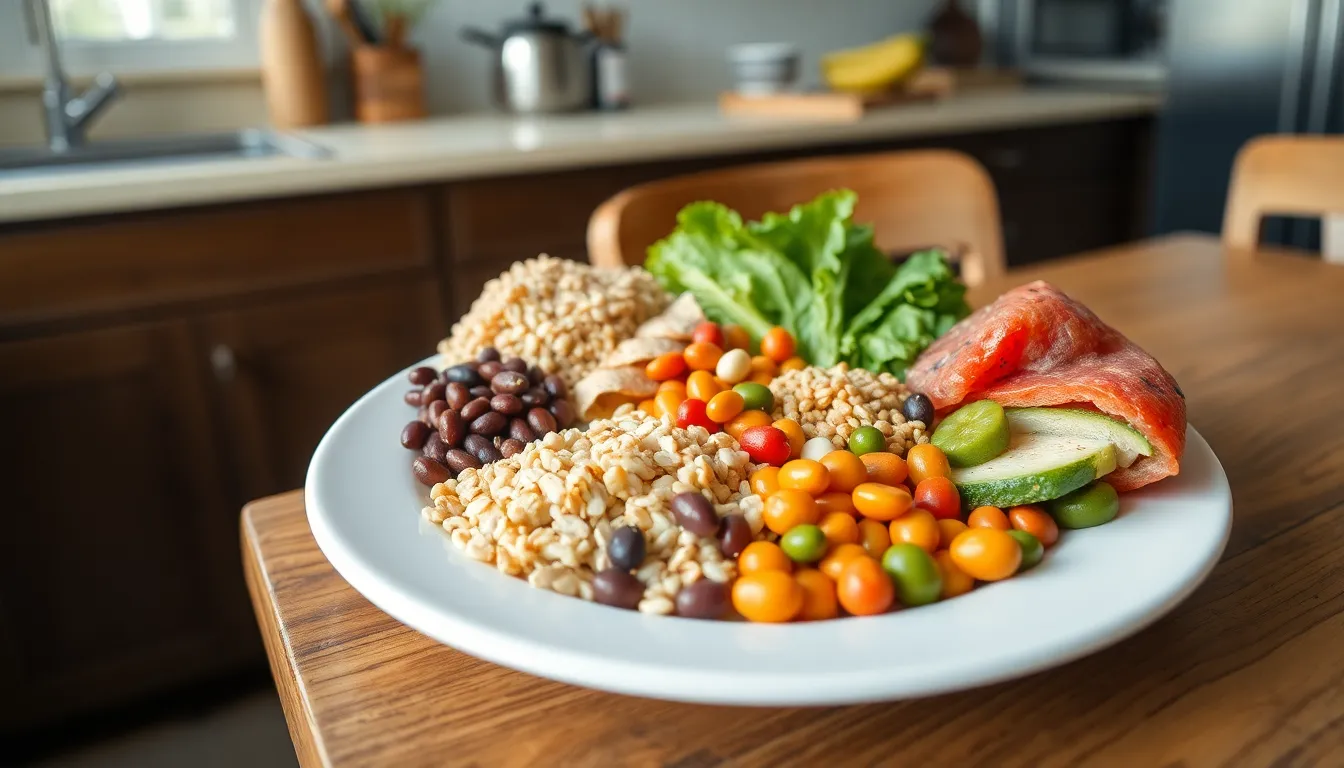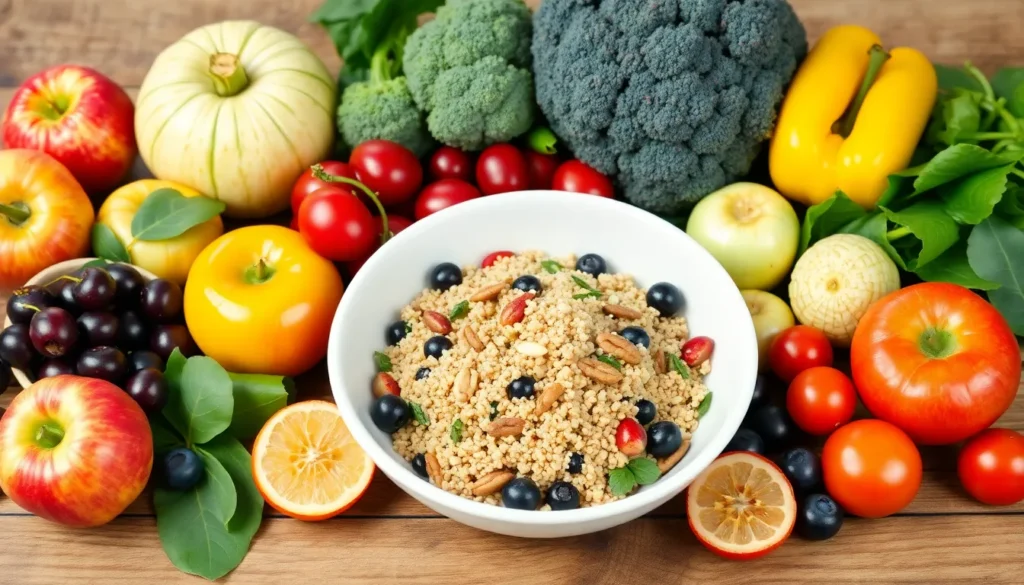Imagine a world where your food choices don’t just satisfy your cravings but also keep your energy levels steady and your mood high. Enter low glycemic index foods—the superheroes of the culinary universe! These tasty delights won’t send your blood sugar on a rollercoaster ride, and they’re here to save you from the dreaded post-lunch slump.
Table of Contents
ToggleWhat Are Low Glycemic Index Foods?
Low glycemic index (GI) foods possess a GI value of 55 or less. These foods release glucose slowly into the bloodstream, preventing rapid spikes in blood sugar levels. Individuals often incorporate low GI foods into their diets to maintain steady energy and improved focus throughout the day.
Examples of low GI foods include non-starchy vegetables like broccoli, leafy greens, and tomatoes. Whole grains such as barley, quinoa, and oats also feature low GI values, making them excellent choices for meals and snacks. Fruits like apples, cherries, and oranges contribute to healthy blood sugar levels while providing essential vitamins.
Legumes such as lentils, chickpeas, and black beans offer protein and fiber benefits, enhancing satiety and digestion. Nuts like almonds and walnuts also rank low on the GI scale, providing healthy fats and nutrients without significant sugar impact.
When planning meals, incorporating low GI foods can contribute to better health outcomes. Researchers have found that diets rich in these foods may reduce the risk of type 2 diabetes and cardiovascular diseases. Cooking methods can influence the GI value; for instance, cooking pasta al dente keeps its glycemic index lower compared to overcooking.
Opting for low GI foods allows individuals to satisfy cravings without triggering energy crashes. By prioritizing these foods, people can achieve long-lasting fullness and stable energy levels, enhancing overall well-being.
Benefits of Low Glycemic Index Foods

Low glycemic index foods offer various health advantages, notably in blood sugar control and weight management. Emphasizing these foods can lead to improved overall health.
Blood Sugar Control
Blood sugar regulation is a key benefit of low glycemic index foods. Foods with a GI value of 55 or less release glucose gradually into the bloodstream. This slow release prevents rapid spikes and subsequent drops in blood sugar levels. Maintaining stable blood sugar helps enhance energy and concentration. For example, incorporating whole grains like barley can support steady glucose levels. Legumes such as lentils also contribute to improved blood sugar control. Individuals prioritizing low GI foods often experience fewer cravings, reducing the risk of energy crashes throughout the day.
Weight Management
Weight management becomes simpler with low glycemic index foods. Such foods tend to have a higher fiber content, promoting satiety and reducing overall caloric intake. Eating non-starchy vegetables, like broccoli, offers volume with fewer calories. Additionally, whole grains provide sustained energy, helping to curb hunger between meals. Studies show that individuals consuming low GI foods report feeling fuller longer. By choosing fruits and nuts, people can enjoy satisfying snacks that do not lead to weight gain. Prioritizing low GI foods supports long-term weight management efforts and healthier lifestyles.
Popular Low Glycemic Index Foods
Low glycemic index foods include a variety of options that promote better health outcomes, including stable energy and improved blood sugar regulation. The following foods stand out in the low GI category.
Fruits and Vegetables
Berries like blueberries and strawberries rank low on the glycemic index, making them excellent choices. Cherries and apples also provide flavor while supporting blood sugar control. Non-starchy vegetables, including spinach, broccoli, and carrots, contribute vital nutrients without raising blood sugar. Avocados offer healthy fats along with their low GI status, promoting satiety and overall health. Incorporating these fruits and vegetables into daily meals helps maintain stable energy levels and curbs cravings.
Grains and Legumes
Whole grains such as quinoa, barley, and oats provide complex carbohydrates, keeping blood sugar steady. They contain fiber, which enhances feelings of fullness, leading to better weight management. Legumes like lentils, chickpeas, and black beans contribute protein and fiber, making them great low GI sources for meals. Choosing these grains and legumes enriches diets with essential nutrients while helping to prevent blood sugar spikes. Prioritizing these foods supports long-term health and enhances overall well-being.
How to Incorporate Low Glycemic Index Foods into Your Diet
Incorporating low glycemic index foods into a daily diet enhances health and supports energy stabilization. Following simple strategies helps ensure these foods become a staple in meals.
Meal Planning Tips
Focus on balancing meals with low GI options. Include a variety of non-starchy vegetables like spinach and broccoli to increase fiber intake. Select whole grains such as quinoa and barley for their nutritional benefits. Opt for legumes like lentils and chickpeas as protein sources that also aid in digestion. Planning weekly menus with these items ensures accessibility and variety. Preparing meals in bulk with low GI foods allows for easier choices throughout the week.
Recipes to Try
Consider trying a quinoa salad, mixing cooked quinoa with diced vegetables, nuts, and a light vinaigrette. This combination offers essential nutrients and low GI benefits. Another option is a vegetable stir-fry with bell peppers, broccoli, and tofu, using a small amount of healthy oil for flavor. For breakfast, oatmeal topped with berries and nuts provides a filling start. Experiment with lentil soup, blending spices with lentils, carrots, and celery for a comforting dish. Each of these recipes delivers flavor alongside the benefits of low glycemic index foods.
Embracing low glycemic index foods can transform one’s dietary habits and overall health. These foods not only help maintain stable energy levels but also support better mood and weight management. By incorporating a variety of fruits vegetables grains and legumes into daily meals individuals can experience lasting fullness and improved blood sugar control.
The benefits extend beyond just physical health as these foods can enhance mental clarity and reduce cravings. With practical meal planning and delicious recipe options available integrating low GI foods into everyday life is both achievable and rewarding. Prioritizing these nutrient-rich choices can lead to a healthier lifestyle and long-term well-being.





